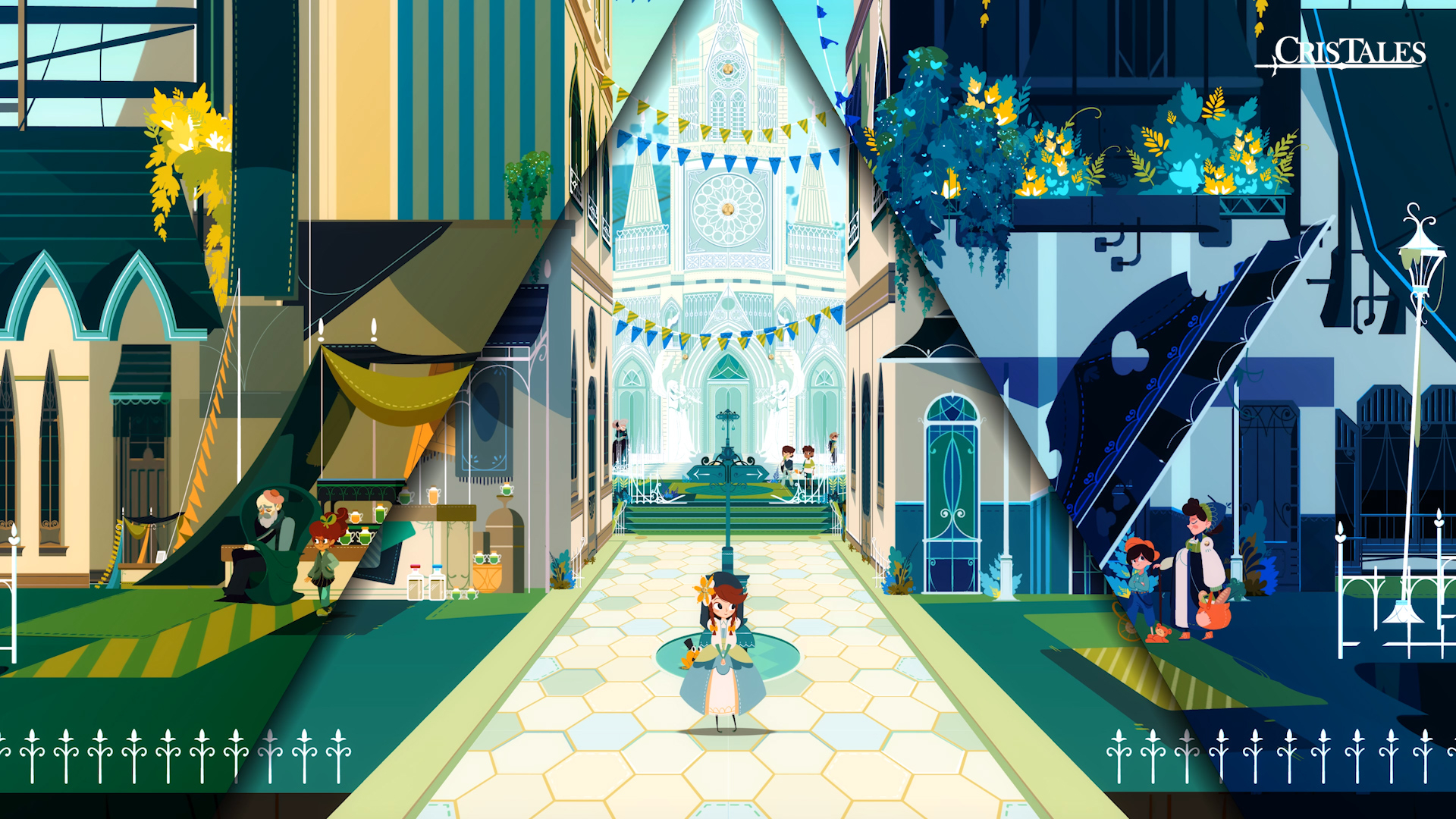The look of Cris Tales will be the first thing that catches your attention.
Built as an homage to the classic turn-based JRPGs of the past, like Final Fantasy VI and Chrono Trigger, the time-bending adventure doesn’t fall back on the familiar pixelated character sprites and worlds seen in its 16-bit inspirations. Instead, Colombia-based indie developer Dreams Uncorporated came to the table with an art style all their own – a hand-drawn, 2D animated look put together through sharply defined colors and shapes.
Seeing it in motion through a guided walkthrough a couple weeks ago, the game looked reminiscent of Genndy Tartakovsky’s animation work, Samurai Jack in particular.
But as Cris Tales’ art director Sebastain Villarreal explained, Tartakovsky was just one of the many influences, both in media and through culture, that helped form the game’s captivating visuals.
“The visual style of Cris Tales is the mixture of many influences such as real places, traditional costumes and the emotions that these things brings to us,” Villarreal said via email. “As previously mentioned, in general the work of Genndy Tartakovsky on Cartoon Network, old school artists such as Mary Blair or Eyvind Earle on Disney, and even the Japanese character stylization like the Utena anime series has been a strong artistic influence on the Cris Tales art development.”
Visual aspects of the game’s characters, Villarreal added, were originally influenced by children’s storybooks and the 2009 animated film Secret of Kells, “because those types of character designs had strong geometric shapes similar to the stained glass windows found in some of the Colombian Cathedrals that we originally wanted to create.”
And just like Cris Tales’ JRPG roots, the Dream Uncorporated team put the architecture, culture, and history of its home country at the core of everything the game does.

The walkthrough, for example, showed off gameplay and story beats within St. Clarity, a city that exists on a stark economic and social divide shown through downtrodden slums overlooked by lavish and pristine wealth on the upper level, much like the real-life Colombian city of Cartagena. And the game’s protagonist, Crisbell, gains her time-controlling powers through visits to stained-glass murals within cathedrals both inspired by the ones that exist in the South American country.
“We created a term that we call ‘endemic fantasy,’” Dreams Uncorporated dev producer Jeff Cardenas said following the guided walkthrough. “It’s basically to strike the magic of all the things in our country….our architecture, our animals, our floral.”
But with game development, ideas change and progress through time, iteration, and trial and error. Cris Tales’ art style was no different. Take the design of the Crisbell, for instance.
“The initial concept art of Crisbell had a look quite similar to the characters that can be seen in Secret of Kells, in a more religious and ‘hard edge’ tone,” Villarreal said. “But we gradually took this style toward another path to match the character that we wanted to create in this world: A humble girl with pigtails, traditional clothes like the veil on her head, a bell shaped skirt similar to Disney princesses like Belle, and of course the simple kindness that characterizes the inhabitants of Narim (Crisbell’s hometown and where the game’s story begins).”

There was practicality to consider too, as Villarreal noted that a game’s visual style is often affected by decisions made in other aspects of development.
“The Cris Tales characters were never animated with a separation line for the colors,” Villarreal said. “This decision was made because it allowed us to animate the cut-out pieces more easily and prevent the joints of the characters from being misplaced. Using solid colors was a great idea to make animations more effective.”
There was also an idea in the beginning for a world made of fabric, needles, and threads of wool, which Villarreal said the team felt would have been “a beautiful way of representing the crops and agriculture of the landscapes of the countryside fields of Colombia.” But because of the way Cris Tales handles time — where the past, present, and projected future are on display all at once, thus requiring at least three versions of every asset and character in the game — the team gradually shifted to a more manageable approach.
“This idea was discarded little by little as time passed, because it took a long time to craft each asset [and] fabric texture in its different versions of ‘past’, ‘present’, and ‘future,’” Villarreal said. “In addition to this problem, the most distant objects such as mountains created unnecessary visual noise due to the fabric texture, so this idea was simplified into more abstract patches of fabric based only on solid colors.”
Still, Villarreal believes that the art style they ultimately arrived to captures the spirit of what Dreams Uncoporated is trying to deliver on with this game.
“We believe that the original artistic soul is there,” he said. “But in a way that allows us to bring the correct exposition of the Cris Tales story and unique game mechanics.”
Cris Tales launches November 17 for the PlayStation 4, Xbox One, Nintendo Switch, PC, and Google Stadia. It will also see a PS5 and Xbox Series X release after the consoles launch this Holiday. In the meantime, there’s a recently updated demo available for download now on Steam and GOG.
The post Cris Tales — How Dreams Uncorporated Established The Look of the Game by Nick Tricome appeared first on DualShockers.
